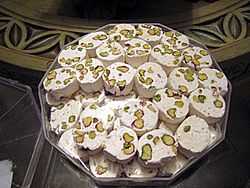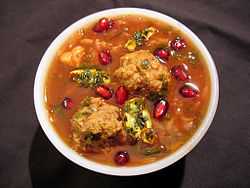Gaz (candy)
| Gaz | |
|---|---|
|
Persian gaz candy | |
| Type | Confectionery (nougat) |
| Place of origin | Iran |
| Region or state | Esfahan |
| Main ingredients | Gaz of Khunsar or sugar or corn syrup, pistachio or almond kernels, rosewater, egg whites |
|
| |
Gaz (Persian: گز) is the traditional name of Persian nougat originating from the city of Esfahan and Boldaji, located in the central plateau of Iran. The same nougat is also made in Iraq, where it is known as mann al-samaʼ (Arabic: من السماء) 'manna from heaven' from the belief that its basic ingredient was sent to the Banī Isrāʼīl from the sky and among Iraqi Jews it is known as Baba Kadrasi.
The name gaz is associated with gaz-angebin which translates to 'sap of angebin', in reference to a species of Tamarisk, T. gallica[1] that is native to the Zagros mountain range located to the west of the city.
The sweet, milky sap (gaz of Khunsar) found on the angebin plant is associated with manna, a food mentioned in the religious texts of the Abrahamic religions. The sticky white substance is exuded from the anus of the nymph of a psyllid insect, either Cyamophila astragalicola[2] or C. dicora,[3] in its final instar, which live on plants of Astragalus adscendens,[2] and is collected annually and is combined with other ingredients including pistachio or almond kernels, rosewater and egg white. Modern versions of gaz may not contain gaz of Khunsar and may use sugar and corn syrup as substitutes for psyllid manna.[4][5] This combination of ingredients gives gaz its distinctive flavour, rendering it unique when compared to European nougats.
Preparation
Once collected from the mountains, the "gaz" (in Persian : گز) of Khunsar is brought into town and placed into very large copper vessels which contain the remaining ingredients of egg white, pistachio or almond kernels, and rose water. The raw mixture is then beaten over heat until it reaches the desired consistency.
Traditionally (and still today) gaz-nougat is handmade and fashioned into individual round pieces of about 2–3 inches in diameter and half an inch in thickness- packed into a wooden box (nowadays cardboard, metal or plastic boxes are used) and covered with plain flour to keep the pieces from sticking to one another. They may be cut into bite-sized pieces, but are more often sold in larger sizes. Gaz in flour is called "gaz-e-ardi"'.
In modern times and with the advent of automated machines capable of mixing, cutting and wrapping individual bite-sized pieces of gaz, production has increased to commercial levels.
See also
References
- ↑ Wulff, Hans, M.I.T. Press, 1966, The traditional crafts of Persia: their development, technology, and influence on Eastern and Western civilizations
- ↑ 2.0 2.1 Grami, Bahram (1998). "Gaz of Khunsar: The manna of persia". Economic Botany 52 (2): 183–191. doi:10.1007/BF02861207. Retrieved 2012-01-04.
- ↑ "Gaz(1)". Encyclopædia Iranica. 2000. Retrieved 2012-01-04.
- ↑ http://candy.about.com/od/nougatcandyrecipes/r/persian_nougat.htm
- ↑ http://www.ciaosamin.com/2011/09/gaz-persian-nougat.html
| |||||||||||||||||||||||||||||||||||||||||||||||||||||||||||||||||||||||

